2017 FORD F150 instrument panel
[x] Cancel search: instrument panelPage 8 of 599

Cleaning Products......................................340
Cleaning the Exterior...................................341
Waxing.............................................................342
Cleaning the Engine....................................342
Cleaning the Windows and Wiper Blades..........................................................343
Cleaning the Interior...................................343
Cleaning the Instrument Panel and Instrument Cluster Lens.......................344
Cleaning Leather Seats.............................344
Repairing Minor Paint Damage
..............345
Cleaning the Wheels
..................................346
Vehicle Storage
............................................346
Wheels and Tires
General Information...................................349
Tire Care
...........................................................351
Using Snow Chains.....................................366
Tire Pressure Monitoring System
...........367
Changing a Road Wheel............................372
Technical Specifications
..........................380
Capacities and Specific- ations
Engine Specifications - 2.7L EcoBoost™.................................................381
Engine Specifications - 3.5L.....................381
Engine Specifications - 3.5L Ecoboost™................................................382
Engine Specifications - 5.0L...................383
Motorcraft Parts - 2.7L EcoBoost™
......383
Motorcraft Parts - 3.5L..............................384
Motorcraft Parts - 3.5L Ecoboost™......385
Motorcraft Parts - 5.0L
.............................385
Vehicle Identification Number
...............386
Vehicle Certification Label.......................387
Transmission Code Designation............387
Capacities and Specifications - 2.7L EcoBoost™...............................................388
Capacities and Specifications - 3.5L....392 Capacities and Specifications - 3.5L
Ecoboost™................................................396
Capacities and Specifications - 5.0L..............................................................400
Audio System
General Information...................................405
Audio Unit - Vehicles With: AM/FM......406
Audio Unit - Vehicles With: AM/FM/ CD.................................................................408
Audio Unit - Vehicles With: AM/FM/ SYNC..............................................................411
Audio Unit - Vehicles With: AM/FM/CD/ SYNC/Satellite Radio
.............................413
Audio Unit - Vehicles With: Sony AM/FM/ CD...................................................................415
Digital Radio
...................................................417
Satellite Radio
...............................................419
USB Port
..........................................................422
Media Hub
......................................................422
SYNC™
General Information
...................................423
Using Voice Recognition...........................425
Using SYNC™ With Your Phone
............427
SYNC™ Applications and Services......439
Using SYNC™ With Your Media Player...........................................................444
SYNC™ Troubleshooting.........................453
SYNC™ 3
General Information
....................................461
Home Screen
.................................................472
Using Voice Recognition............................473
Entertainment..............................................480
Climate...........................................................490
Phone...............................................................492
Navigation......................................................498
Apps
.................................................................506
Settings...........................................................509
SYNC™ 3 Troubleshooting.......................521
5
F-150 (TFC) Canada/United States of America, enUSA, First Printing Table of Contents
Page 50 of 599
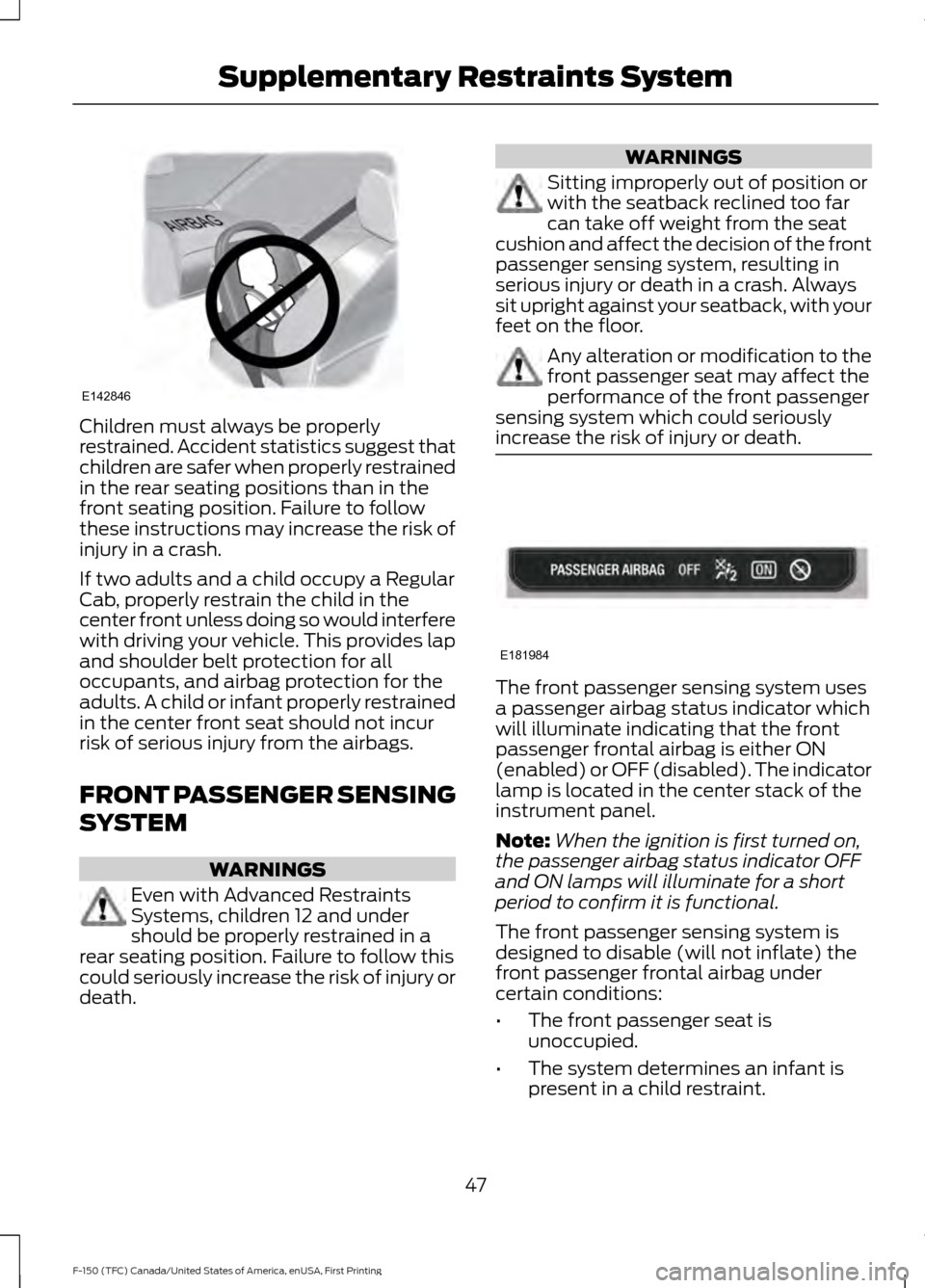
Children must always be properly
restrained. Accident statistics suggest that
children are safer when properly restrained
in the rear seating positions than in the
front seating position. Failure to follow
these instructions may increase the risk of
injury in a crash.
If two adults and a child occupy a Regular
Cab, properly restrain the child in the
center front unless doing so would interfere
with driving your vehicle. This provides lap
and shoulder belt protection for all
occupants, and airbag protection for the
adults. A child or infant properly restrained
in the center front seat should not incur
risk of serious injury from the airbags.
FRONT PASSENGER SENSING
SYSTEM
WARNINGS
Even with Advanced Restraints
Systems, children 12 and under
should be properly restrained in a
rear seating position. Failure to follow this
could seriously increase the risk of injury or
death. WARNINGS
Sitting improperly out of position or
with the seatback reclined too far
can take off weight from the seat
cushion and affect the decision of the front
passenger sensing system, resulting in
serious injury or death in a crash. Always
sit upright against your seatback, with your
feet on the floor. Any alteration or modification to the
front passenger seat may affect the
performance of the front passenger
sensing system which could seriously
increase the risk of injury or death. The front passenger sensing system uses
a passenger airbag status indicator which
will illuminate indicating that the front
passenger frontal airbag is either ON
(enabled) or OFF (disabled). The indicator
lamp is located in the center stack of the
instrument panel.
Note:
When the ignition is first turned on,
the passenger airbag status indicator OFF
and ON lamps will illuminate for a short
period to confirm it is functional.
The front passenger sensing system is
designed to disable (will not inflate) the
front passenger frontal airbag under
certain conditions:
• The front passenger seat is
unoccupied.
• The system determines an infant is
present in a child restraint.
47
F-150 (TFC) Canada/United States of America, enUSA, First Printing Supplementary Restraints SystemE142846 E181984
Page 87 of 599
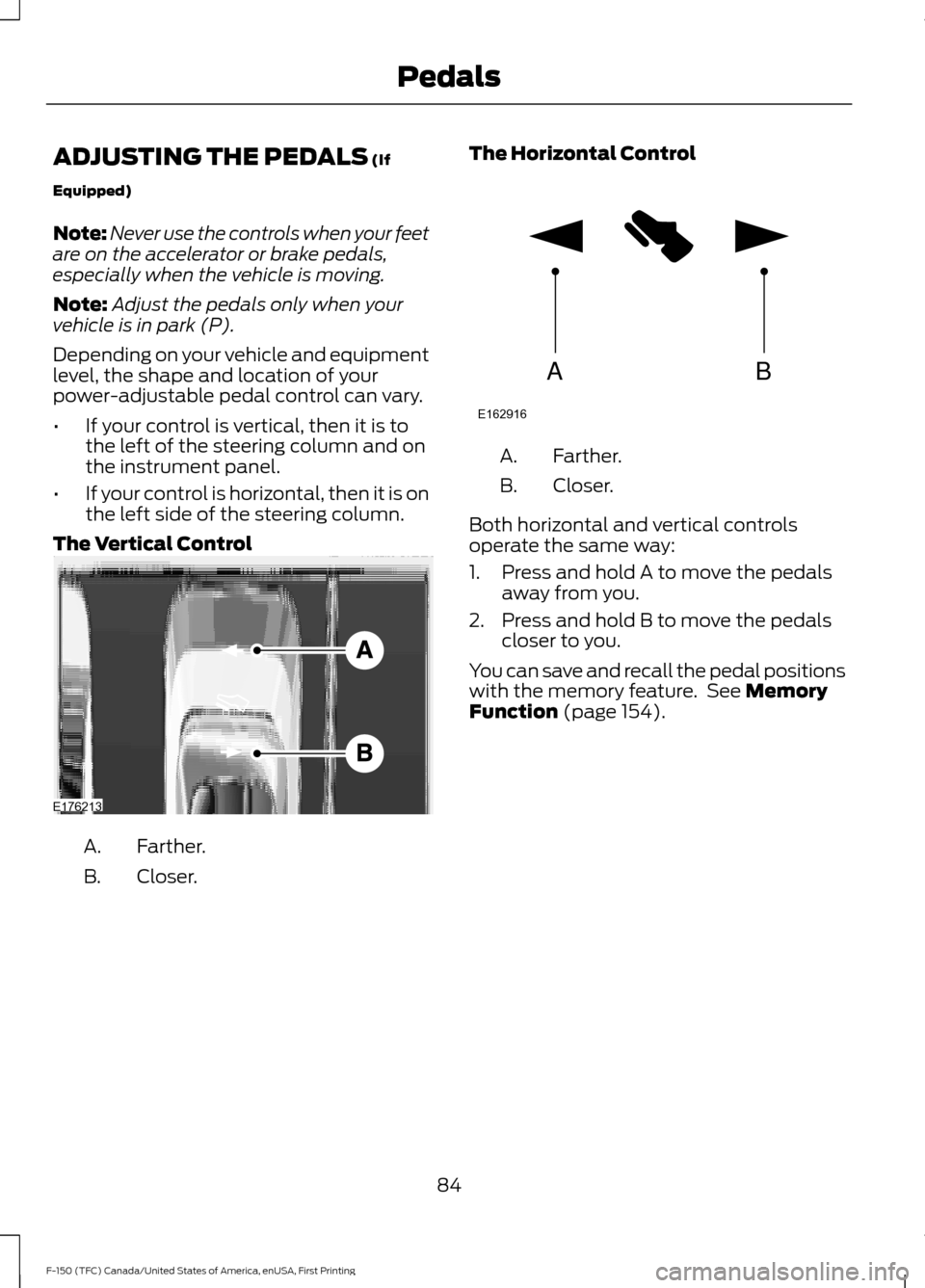
ADJUSTING THE PEDALS (If
Equipped)
Note: Never use the controls when your feet
are on the accelerator or brake pedals,
especially when the vehicle is moving.
Note: Adjust the pedals only when your
vehicle is in park (P).
Depending on your vehicle and equipment
level, the shape and location of your
power-adjustable pedal control can vary.
• If your control is vertical, then it is to
the left of the steering column and on
the instrument panel.
• If your control is horizontal, then it is on
the left side of the steering column.
The Vertical Control Farther.
A.
Closer.
B. The Horizontal Control Farther.
A.
Closer.
B.
Both horizontal and vertical controls
operate the same way:
1. Press and hold A to move the pedals away from you.
2. Press and hold B to move the pedals closer to you.
You can save and recall the pedal positions
with the memory feature. See
Memory
Function (page 154).
84
F-150 (TFC) Canada/United States of America, enUSA, First Printing PedalsE176213 AB
E162916
Page 90 of 599

LIGHTING CONTROL
Off.A
Parking lamps, instrument panel
lamps, license plate lamps and
rear lamps.
B
Headlamps.
C
High Beam Push the lever away from you to switch
the high beam on.
Push the lever forward again or pull the
lever toward you to switch the high beams
off. Headlamp Flasher
Slightly pull the lever toward you and
release it to flash the headlamps.
AUTOLAMPS (If Equipped)
WARNING
The autolamps switch position may
not activate the headlamps in all low
visibility conditions, such as daytime
fog. Always ensure that your headlamps
are switched to auto or on, as appropriate,
during all low visibility conditions. Failure
to do so may result in a collision. When the lighting control is in the
autolamps position, the headlamps
automatically turn on in low light situations
or when the wipers activate.
87
F-150 (TFC) Canada/United States of America, enUSA, First Printing LightingE142449 E167827 E163268 E142451
Page 101 of 599

To adjust your mirrors, make sure you
switch your vehicle on (with the ignition in
accessory mode or the engine running) and
then:
1. Press and release the control. It lights.
2. Press the adjustment control to
position the mirrors.
•Press the left arrow to extend the
mirrors out. Press the right arrow to
retract the mirrors in.
• Press the up or down arrow to fold
the mirrors toward the window
glass. Press the up or down arrow
again to fold the mirrors out.
Note: Moving the mirrors 10 or more times
within one minute, or repeated folding and
unfolding of the mirrors while holding the
control down during full travel, may disable
the system to protect the motors from
overheating. Wait approximately three
minutes with the vehicle running, and up to
10 minutes with the vehicle off, for the
system to reset and for function to return to
normal.
Heated Exterior Mirrors (If Equipped)
See Heated Windows and Mirrors (page
147
). Memory Mirrors
(If Equipped)
You can save and recall the mirror
positions through the memory function.
See
Memory Function (page 154).
Auto-dimming Feature
(If Equipped)
The driver exterior mirror automatically
dims when the interior auto-dimming
mirror turns on.
Direction Indicator Mirrors (If Equipped)
While the vehicle is running, the
forward-facing portion of the appropriate
mirror housing blinks when you switch on
the direction indicator.
Puddle Lamps
(If Equipped)
The lamps on the bottom part of the mirror
housing light when you use your
transmitter to unlock the doors or when
you open a door.
Clearance Lamps
(If Equipped)
The lower, outer part of the mirror housings
light when you switch the headlamps or
parking lamps on.
Spot Lamps
(If Equipped)
The area lights are on the forward-facing
portion of the mirror housing. You can
switch them on and off by using the
controls located on the instrument panel.
See
Lighting (page 87).
360-Degree Camera
(If Equipped)
Each mirror includes a camera.
Integrated Blind Spot Mirror
(If
Equipped) WARNING
Objects in the blind spot mirror are
closer than they appear.
98
F-150 (TFC) Canada/United States of America, enUSA, First Printing Windows and MirrorsE176218
Page 144 of 599
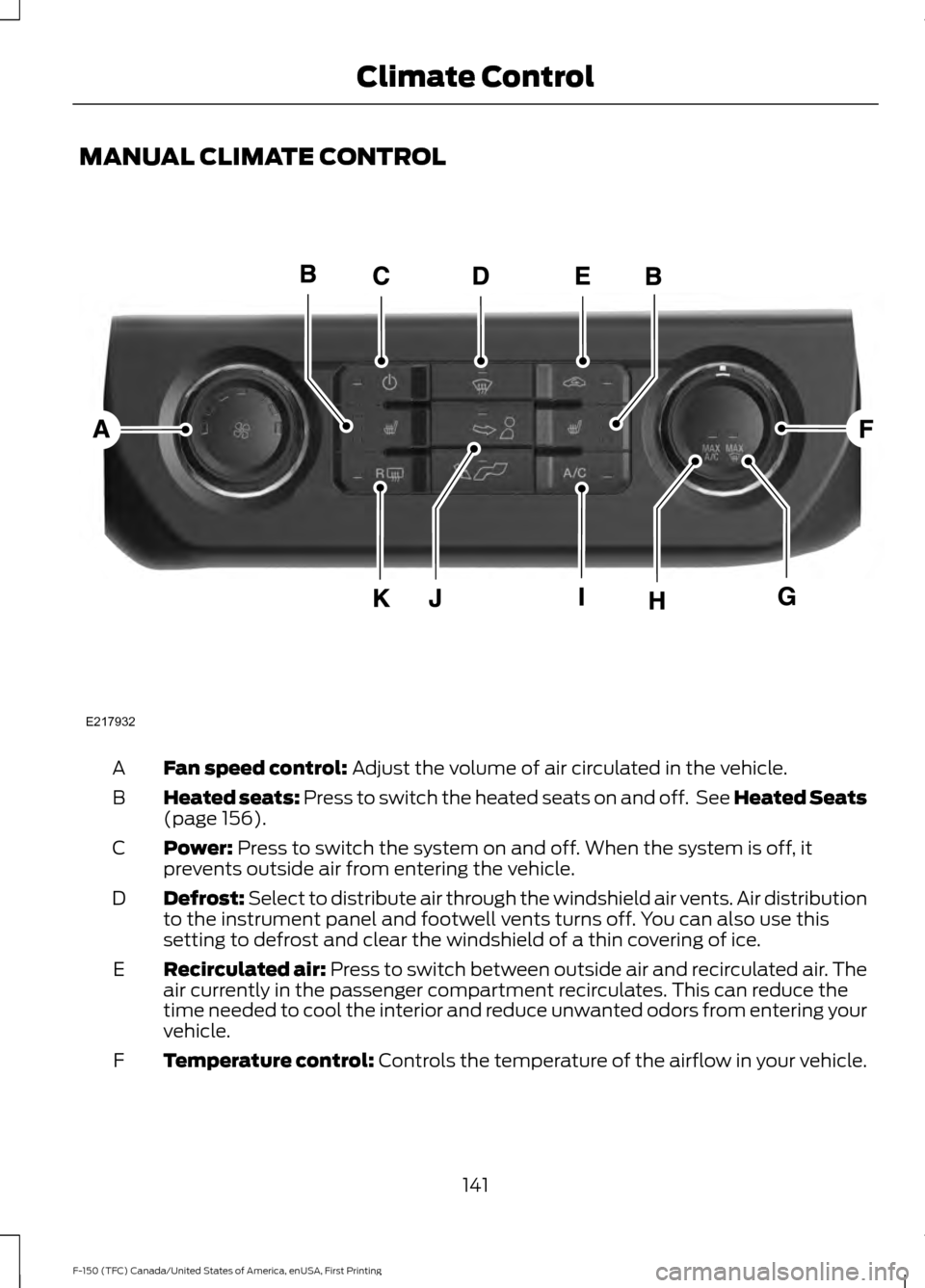
MANUAL CLIMATE CONTROL
Fan speed control: Adjust the volume of air circulated in the vehicle.
A
Heated seats:
Press to switch the heated seats on and off. See Heated Seats
(page 156).
B
Power:
Press to switch the system on and off. When the system is off, it
prevents outside air from entering the vehicle.
C
Defrost: Select to distribute air through the windshield air vents. Air distribution
to the instrument panel and footwell vents turns off. You can also use this
setting to defrost and clear the windshield of a thin covering of ice.
D
Recirculated air:
Press to switch between outside air and recirculated air. The
air currently in the passenger compartment recirculates. This can reduce the
time needed to cool the interior and reduce unwanted odors from entering your
vehicle.
E
Temperature control:
Controls the temperature of the airflow in your vehicle.
F
141
F-150 (TFC) Canada/United States of America, enUSA, First Printing Climate ControlE217932
Page 145 of 599
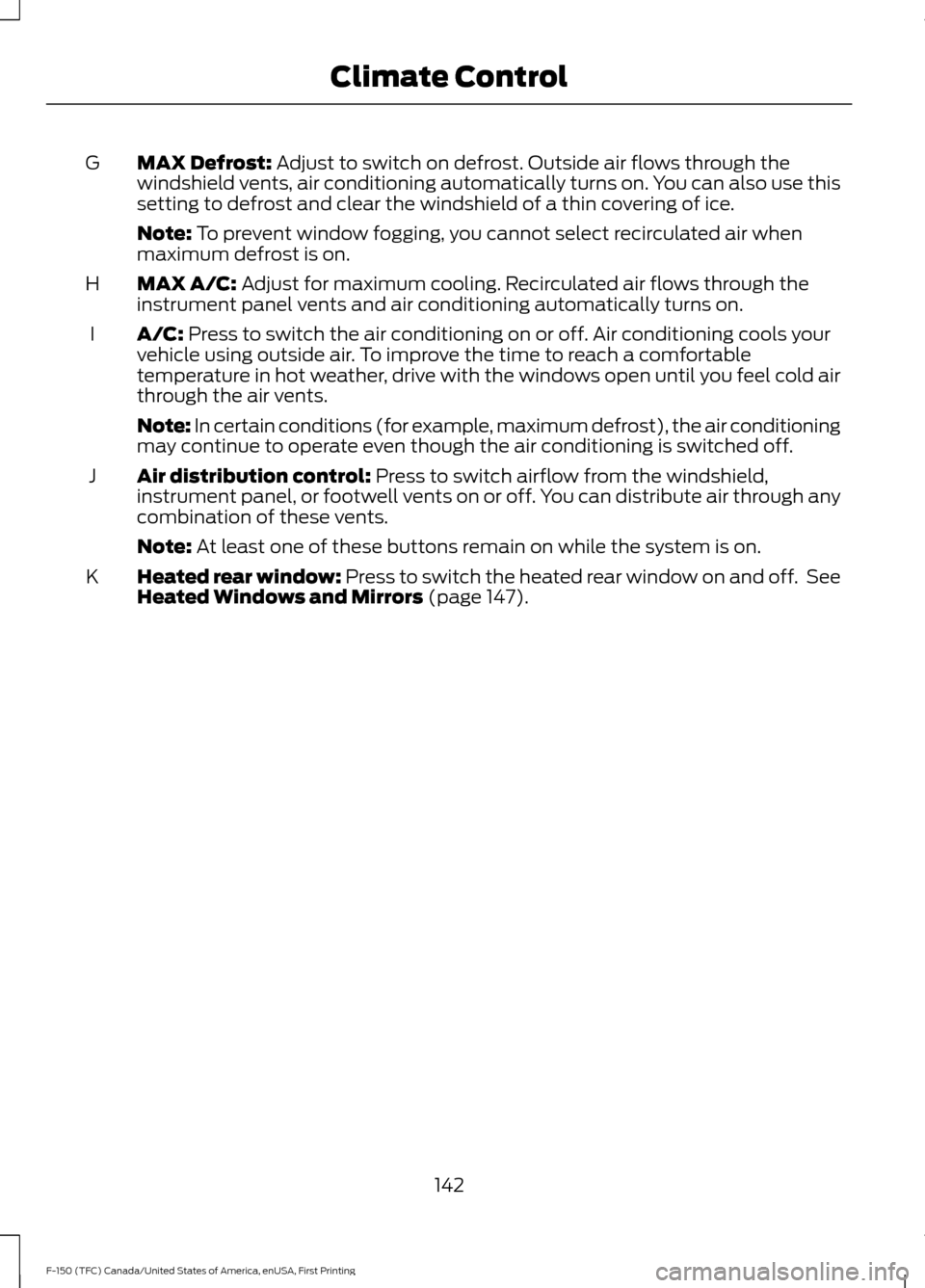
MAX Defrost: Adjust to switch on defrost. Outside air flows through the
windshield vents, air conditioning automatically turns on. You can also use this
setting to defrost and clear the windshield of a thin covering of ice.
G
Note:
To prevent window fogging, you cannot select recirculated air when
maximum defrost is on.
MAX A/C:
Adjust for maximum cooling. Recirculated air flows through the
instrument panel vents and air conditioning automatically turns on.
H
A/C:
Press to switch the air conditioning on or off. Air conditioning cools your
vehicle using outside air. To improve the time to reach a comfortable
temperature in hot weather, drive with the windows open until you feel cold air
through the air vents.
I
Note: In certain conditions (for example, maximum defrost), the air conditioning
may continue to operate even though the air conditioning is switched off.
Air distribution control:
Press to switch airflow from the windshield,
instrument panel, or footwell vents on or off. You can distribute air through any
combination of these vents.
J
Note:
At least one of these buttons remain on while the system is on.
Heated rear window: Press to switch the heated rear window on and off. See
Heated Windows and Mirrors
(page 147).
K
142
F-150 (TFC) Canada/United States of America, enUSA, First Printing Climate Control
Page 146 of 599
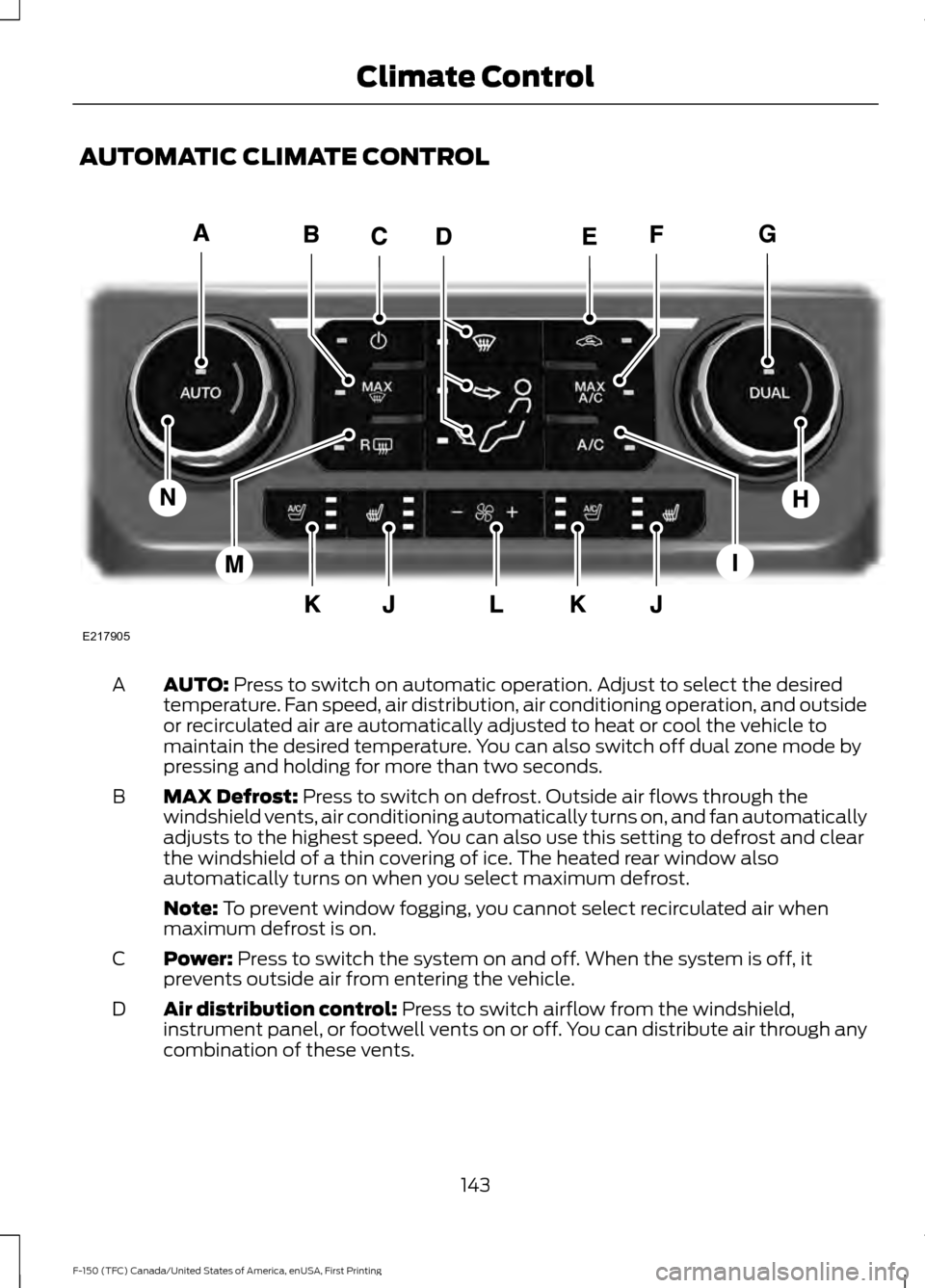
AUTOMATIC CLIMATE CONTROL
AUTO: Press to switch on automatic operation. Adjust to select the desired
temperature. Fan speed, air distribution, air conditioning operation, and outside
or recirculated air are automatically adjusted to heat or cool the vehicle to
maintain the desired temperature. You can also switch off dual zone mode by
pressing and holding for more than two seconds.
A
MAX Defrost:
Press to switch on defrost. Outside air flows through the
windshield vents, air conditioning automatically turns on, and fan automatically
adjusts to the highest speed. You can also use this setting to defrost and clear
the windshield of a thin covering of ice. The heated rear window also
automatically turns on when you select maximum defrost.
B
Note:
To prevent window fogging, you cannot select recirculated air when
maximum defrost is on.
Power:
Press to switch the system on and off. When the system is off, it
prevents outside air from entering the vehicle.
C
Air distribution control:
Press to switch airflow from the windshield,
instrument panel, or footwell vents on or off. You can distribute air through any
combination of these vents.
D
143
F-150 (TFC) Canada/United States of America, enUSA, First Printing Climate ControlE217905